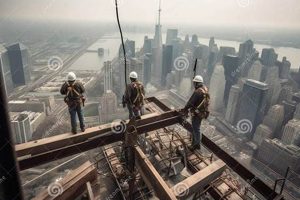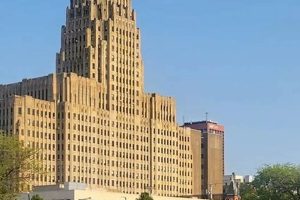Woolworth Building, a neo-Gothic skyscraper at 233 Broadway in the Civic Center area of Lower Manhattan, New York City. Designed by architect Cass Gilbert, its construction began in 1910 and was completed in 1913. Standing 792 feet (241 meters) tall with 57 stories, it was the world’s tallest building until surpassed by the Bank of Manhattan Trust Building at 40 Wall Street in 1930.
The Woolworth Building was commissioned by retail magnate Frank W. Woolworth, who wanted a headquarters for his F. W. Woolworth Company. It was designed in a neo-Gothic style, with a steel frame and a facade of terracotta and limestone. The building’s design was inspired by the Cologne Cathedral in Germany and features many Gothic details, such as pointed arches, ribbed vaults, and flying buttresses.
The Woolworth Building is an important example of early 20th-century skyscraper architecture. It was one of the first buildings to use a steel frame, and its design influenced the development of skyscrapers in the years that followed. The building is also a popular tourist destination, and it has been featured in numerous films and television shows.
1. Height
The Woolworth Building’s height of 792 feet (241 meters) was a defining characteristic that contributed to its significance and lasting impact. When it was completed in 1913, it became the tallest building in the world, surpassing the Metropolitan Life Insurance Tower. This achievement was a testament to the architectural prowess of its time and solidified the Woolworth Building’s place in history.
The building’s height was not merely a matter of aesthetics; it also had practical implications. The additional stories allowed for more office space, accommodating the growing needs of the F. W. Woolworth Company. The height also provided tenants with panoramic views of the city, making the building a desirable location for businesses.
The Woolworth Building’s height continues to be an important aspect of its legacy. It remains one of the tallest buildings in New York City and is easily recognizable from afar. Its height serves as a reminder of the architectural advancements of the early 20th century and the enduring impact of the Woolworth Building on the city’s skyline.
2. Stories
The Woolworth Building’s 57 stories were a significant aspect of its design and had several implications. Firstly, the number of stories allowed for more office space, accommodating the growing needs of the F. W. Woolworth Company. The additional space provided ample room for the company’s operations and employees, contributing to its success and growth.
Secondly, the 57 stories had a practical significance in terms of elevator technology. At the time of the building’s construction, elevators were still relatively new and had limited capacity. The 57 stories necessitated the installation of multiple elevators to efficiently transport tenants and visitors throughout the building. This advanced elevator system set a precedent for future skyscrapers and influenced the development of vertical transportation.
Furthermore, the 57 stories contributed to the Woolworth Building’s iconic status and architectural impact. The sheer height and number of stories made the building a prominent landmark in the New York City skyline. Its distinctive silhouette and Gothic design, combined with its towering height, have made it a recognizable symbol of the city’s architectural heritage.
3. Architect
Cass Gilbert, a prominent American architect, played a pivotal role in the design and construction of the Woolworth Building. His vision and architectural prowess left an indelible mark on the building, contributing to its iconic status and architectural significance.
Gilbert’s involvement in the Woolworth Building began in 1910 when he was commissioned by Frank W. Woolworth to design the headquarters for his retail empire. Gilbert embraced the challenge, meticulously crafting a design that would reflect the company’s success and grandeur. He drew inspiration from the Gothic Revival style, particularly the Cologne Cathedral, incorporating intricate details and soaring heights into the building’s design.
Gilbert’s architectural expertise was evident in the Woolworth Building’s innovative structural system. He employed a steel frame, a relatively new technology at the time, to achieve the building’s impressive height and stability. The steel frame allowed for larger windows, providing ample natural light and stunning views for the building’s occupants. Gilbert’s thoughtful design not only ensured the building’s structural integrity but also contributed to its aesthetic appeal and functionality.
4. Style
The Woolworth Building’s architectural style, Neo-Gothic, played a defining role in its overall design and significance. This style, prevalent in the late 19th and early 20th centuries, drew inspiration from medieval Gothic architecture, characterized by its pointed arches, ribbed vaults, and flying buttresses.
- Verticality and Height:
Neo-Gothic architecture emphasized verticality, aspiring towards the heavens. The Woolworth Building’s soaring height of 792 feet, achieved through its steel frame construction, exemplified this characteristic. The pointed arches and ribbed vaults further accentuated the building’s upward thrust, creating a sense of grandeur and aspiration.
- Ornate Details:
Neo-Gothic architecture was known for its intricate and elaborate ornamentation. The Woolworth Building showcased this through its terracotta and limestone facade, adorned with carvings, sculptures, and decorative elements. These details, inspired by medieval cathedrals, added a layer of visual interest and historical reference to the building’s exterior.
- Symbolism and Meaning:
Neo-Gothic architecture carried symbolic meanings, often associated with power, authority, and religious devotion. The Woolworth Building, as the headquarters of a successful retail empire, embodied these qualities. Its Gothic design conveyed a sense of permanence, stability, and aspiration, reflecting the company’s values and ambitions.
- Influence on Skyscraper Architecture:
The Woolworth Building’s Neo-Gothic style influenced the development of skyscraper architecture. Its success demonstrated the viability of incorporating historical architectural elements into modern high-rise buildings. This approach inspired other architects to explore the integration of different styles and inf
luences in their skyscraper designs.
In conclusion, the Neo-Gothic style of the Woolworth Building was an integral part of its design and significance. It contributed to the building’s verticality, ornate details, symbolic meanings, and influence on skyscraper architecture, making it a remarkable example of early 20th-century architectural innovation.
5. Construction
The construction of the Woolworth Building from 1910 to 1913 marked a significant period in the history of architecture and engineering. This ambitious project involved several notable facets that contributed to the building’s success and enduring legacy:
- Engineering Innovation: The Woolworth Building was one of the first skyscrapers to utilize a steel frame construction, a revolutionary technique that allowed for greater height and stability. This innovation enabled the building to reach an impressive 792 feet, making it the tallest building in the world at the time.
- Architectural Details: The construction process also involved meticulous attention to architectural details. The building’s facade features intricate terracotta and limestone ornamentation, showcasing the craftsmanship and artistry of the era. These decorative elements, inspired by Gothic cathedrals, added a touch of grandeur and historical reference to the building’s exterior.
- Technological Advancements: The construction of the Woolworth Building coincided with advancements in technology. The use of electric elevators, for example, was crucial for efficient vertical transportation within the 57-story building. These technological innovations enhanced the building’s functionality and usability.
- Economic Impact: The construction of the Woolworth Building had a significant economic impact on New York City. It provided employment opportunities for thousands of workers and stimulated the growth of related industries. The building’s presence also contributed to the development of the surrounding area, transforming it into a thriving commercial hub.
In conclusion, the construction of the Woolworth Building from 1910 to 1913 was a remarkable feat of engineering, architecture, and technological innovation. The building’s construction techniques, intricate details, and economic impact continue to inspire and inform modern architecture and construction practices.
6. Purpose
The Woolworth Building’s primary purpose as the headquarters for the F. W. Woolworth Company played a significant role in shaping its design and overall significance. This connection can be explored through several key facets:
- Corporate Identity and Symbolism: The Woolworth Building served as a physical embodiment of the F. W. Woolworth Company, reflecting its success and stature. Its grandeur and architectural details conveyed a sense of power, stability, and permanence, aligning with the company’s values and ambitions.
- Functional Requirements: As the company’s headquarters, the building needed to accommodate a large number of employees and various departments. Its 57 stories and efficient floor plan provided ample space for offices, meeting rooms, and other essential functions, ensuring the smooth operation of the company.
- Centralized Operations: The Woolworth Building’s location in the heart of New York City facilitated centralized operations for the company. Its proximity to transportation hubs and business centers allowed for efficient communication, coordination, and management of the company’s vast retail network.
- Employee Amenities: The building incorporated amenities and facilities to support the well-being and productivity of its employees. These included dining areas,, and recreational spaces, demonstrating the company’s commitment to its workforce.
In conclusion, the Woolworth Building’s purpose as the headquarters for the F. W. Woolworth Company was integral to its design, functionality, and symbolic significance. It served as a physical representation of the company’s success, provided a central hub for its operations, and fostered a supportive work environment for its employees.
7. Landmark
The designation of the Woolworth Building as a landmark in 1983 holds significant historical and architectural implications, further enhancing its legacy and importance within the context of New York City’s built environment.
- Preservation and Protection: Landmark status provides legal protection to the Woolworth Building, ensuring its preservation and safeguarding it from inappropriate alterations or demolition. This designation recognizes the building’s architectural and historical significance, ensuring its continued existence for future generations.
- Cultural Identity and Symbolism: The Woolworth Building has become an iconic symbol of New York City, representing its architectural heritage and cultural identity. Landmark status reinforces this iconic status, solidifying the building’s place in the collective memory of the city and its people.
- Architectural Legacy: As a designated landmark, the Woolworth Building stands as a testament to the architectural achievements of its time. It showcases the innovative use of steel frame construction and the incorporation of Gothic Revival elements, contributing to the development of modern skyscraper architecture.
- Tourism and Economic Impact: Landmark status attracts tourists and visitors from around the world, contributing to the city’s tourism industry. The Woolworth Building’s iconic status makes it a popular destination for architectural enthusiasts and history buffs, generating economic benefits for the surrounding area.
In conclusion, the designation of the Woolworth Building as a landmark in 1983 underscores its enduring value as an architectural masterpiece and cultural icon. This recognition ensures its preservation, celebrates its architectural legacy, and contributes to the city’s tourism and economic vitality.
8. Influence
The Woolworth Building’s influence on skyscraper architecture cannot be overstated. Its innovative design and record-breaking height inspired a generation of architects and engineers to push the boundaries of vertical construction.
One of the most notable ways in which the Woolworth Building influenced skyscraper architecture was through its use of a steel frame. This technique, which allowed for the construction of taller and more slender buildings, became the standard for skyscraper construction in the years that followed.
Another important aspect of the Woolworth Building’s influence was its incorporation of Gothic Revival elements. This style, which was popular in the late 19th and early 20th centuries, added a sense of grandeur and elegance to the building. The Woolworth Building’s Gothic Revival details inspired other architects to incorporate similar elements i
nto their own designs, helping to create a distinctive and recognizable style of skyscraper architecture.
The Woolworth Building’s influence can still be seen in skyscrapers around the world. Many modern skyscrapers incorporate elements of the Woolworth Building’s design, such as its steel frame construction and Gothic Revival details. The building’s legacy as a symbol of architectural innovation and achievement continues to inspire architects and engineers today.
Frequently Asked Questions About the Woolworth Building
The Woolworth Building is one of the most iconic skyscrapers in the world. It was built in 1913 and was the tallest building in the world for many years. Here are some of the most frequently asked questions about the Woolworth Building:
Question 1: How tall is the Woolworth Building?
The Woolworth Building is 792 feet tall.
Question 2: How many stories does the Woolworth Building have?
The Woolworth Building has 57 stories.
Question 3: Who designed the Woolworth Building?
The Woolworth Building was designed by Cass Gilbert.
Question 4: What style of architecture is the Woolworth Building?
The Woolworth Building is an example of neo-Gothic architecture.
Question 5: What is the Woolworth Building used for?
The Woolworth Building was originally built to be the headquarters of the F. W. Woolworth Company. Today, it is used for a variety of purposes, including offices, retail, and tourism.
Question 6: Is the Woolworth Building a landmark?
Yes, the Woolworth Building was designated a New York City landmark in 1983 and a National Historic Landmark in 1989.
The Woolworth Building is a remarkable example of early 20th-century architecture. It is a testament to the skill and ingenuity of its creators and continues to be a source of pride for New Yorkers and visitors alike.
To learn more about the Woolworth Building, visit the building’s website or take a guided tour.
Tips for Visiting the Woolworth Building
The Woolworth Building is one of New York City’s most iconic skyscrapers. It was built in 1913 and was the tallest building in the world for many years. Today, it is a popular tourist destination, and visitors can enjoy stunning views of the city from its observation deck.
Tip 1: Book your tickets in advance. The Woolworth Building is a popular tourist destination, so it is important to book your tickets in advance, especially if you are visiting during peak season. You can book tickets online or by phone, and there are a variety of ticket options available.
Arrive early. The Woolworth Building is a large building, and it can take some time to get through security and to the observation deck. Arrive early to avoid long lines, and give yourself plenty of time to explore the building at your own pace.
Take the elevator to the observation deck. The Woolworth Building has 57 stories, and the observation deck is located on the 58th floor. You can take the elevator to the observation deck, or you can climb the stairs. If you choose to climb the stairs, be aware that it is a long climb, and it is not recommended for people with mobility issues.
Enjoy the views. The observation deck offers stunning views of New York City. You can see Central Park, the Empire State Building, the Statue of Liberty, and many other landmarks. Be sure to bring your camera to capture the views.
Visit the gift shop. The Woolworth Building has a gift shop where you can buy souvenirs, including postcards, t-shirts, and other items. The gift shop is located on the ground floor of the building.
Summary of Key Takeaways:
- Book your tickets in advance.
- Arrive early.
- Take the elevator to the observation deck.
- Enjoy the views.
- Visit the gift shop.
By following these tips, you can make the most of your visit to the Woolworth Building.
Conclusion
As one of the most iconic skyscrapers in the world, the Woolworth Building stands as a testament to the architectural prowess and ambition of the early 20th century. Its innovative design, intricate details, and historical significance continue to captivate and inspire architects, engineers, and visitors alike.
The Woolworth Building’s enduring legacy lies not only in its physical presence but also in its influence on the development of skyscraper architecture. Its use of a steel frame, incorporation of Gothic Revival elements, and record-breaking height set a new standard for vertical construction and influenced the design of countless skyscrapers that followed. Today, the Woolworth Building remains a symbol of architectural achievement and a reminder of the transformative power of human ingenuity.







